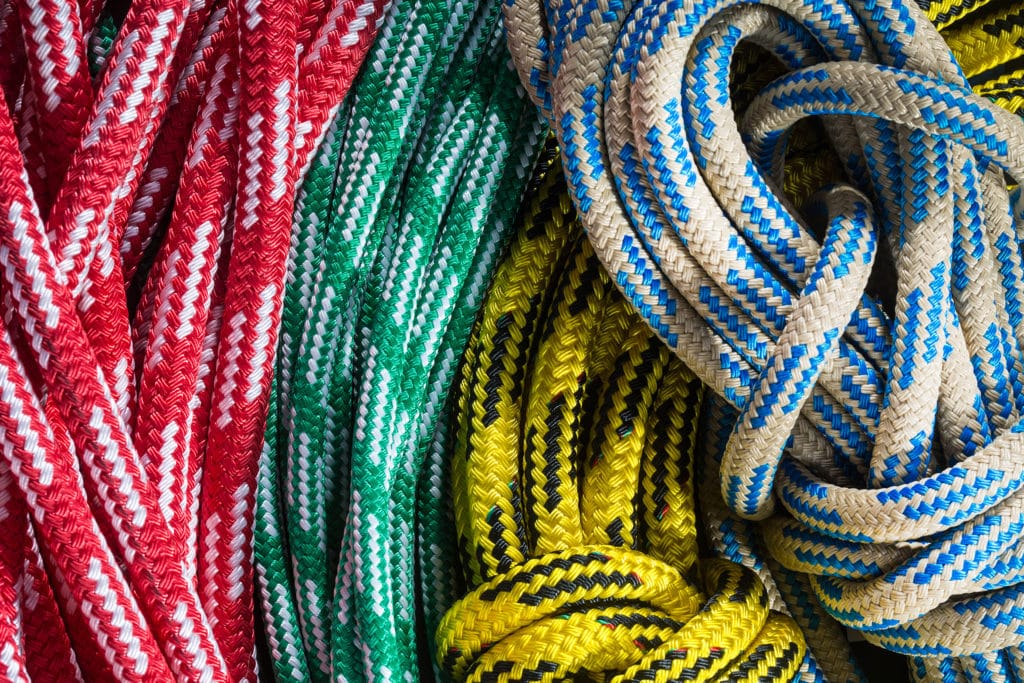
I often sail on boats where the owner has recently purchased new running rigging, and just as often I note that the new rigging isn’t quite perfect. Often, that’s because many boat owners don’t know what to ask for when talking to their rigger. Here are some guidelines.
Some simple terminology
Taper:To safe weight, many lines are stripped of their cover where the cover is not needed. The area where the cover stops and is then buried into the core is the taper.
Core bump: As line technology advances, many lines can be smaller than the clutches that were originally designed with the boat can handle. A core bump is a smaller line inserted into the primary core in the area where the line would pass through the clutch when the associated sail is in use. This enlarges the line in that area, allowing the clutch to hold it securely.
Flemish eye: The Flemish eye is a small eye spliced at the tail end to aid in reeving halyards in and out of the mast or through clutches. The Flemish eye is a must for all halyards and “Domino” style clutches. Domino clutches have a series of eyes that the rope passes through inside the clutch rather then the standard clutch that has a mechanism that compresses down on the rope. For sheets using standard compression clutches, a simple whipping is easier to pass through the clutch then a Flemish eye.
Some basics:
- Stopper balls on spinnaker halyards prevent the shackle from damaging the sheave when fully hoisted, thus resulting in added halyard chafe as it runs around the sheave.
- Stopper balls on jib or genoa halyards may prevent full hoist of sails. Thus I rarely use stopper balls on jib halyards.
- Asymmetrical spinnaker sheet ‘pigtails’ should be kept short for efficiency. The shorter the ‘pigtail’ the less the spinnaker clew travels forward in the gybe thus staying full longer and filling on the new gybe sooner.
- Tapers save weight but reduce the life of the line, as exposed core is prone to chafe and UV damage.
Ordering line
If the line passes through a clutch, check the clutch for its rated sizes and be sure it can accept the line. If the line is not passing through a clutch, make sure it is a diameter the crew can hang onto during its intended use. Softer ropes are generally better for purchases, such as cunninghams and travelers, while stiffer ropes are generally better for more direct pulls, such as jib sheets and afterguys.
Finishing
Can the line be tapered to save weight? If so, measure where the taper should be. For example, pull a tape measure up on the halyard being measured for and measure to where the halyard comes out of the mast. Subtract a few inches, and this is your taper location. This process ensures that your mast man is always handling a covered section of line and that the core is out of the elements when the halyard is up.
Chafe Protection
The most common chafe protector on small- to medium-sized boats is a white Dyneema cover. These are put on the halyard for a few feet at the shackle end to eliminate chafe at sheaves and eyes. Many riggers will dye this cover to match the halyard. Further, you can increase the line’s lifespan by pulling all of your halyards to the top of the mast when not in use using a messenger line attached to a Flemish eye at the end of the halyard. If you don’t need an eye, whip the end of the halyard to prevent fraying.
Shackle Choice
I’m partial to the newer soft-style shackles, and my new favorite is the “Button Shackles” that I’ve been purchasing from RigWorks in San Diego. These are very similar to the standard soft shackle, but there is added security because the loop goes around the aluminum button. They are also easier and less time consuming to get on and off.
For more information on caring for and extending the life of your lines, visit the RigWorks website here.









